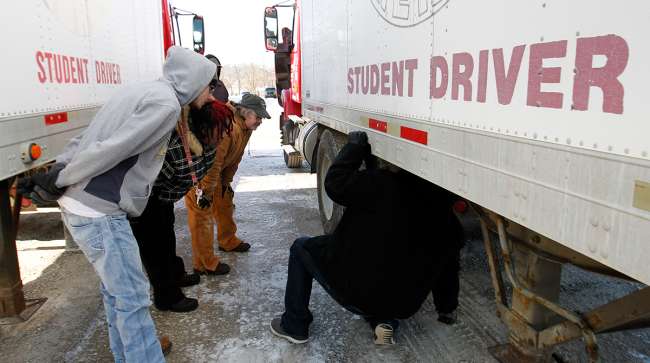Bill Targets Driver Shortage With Age-Restriction Reduction

In an attempt to close a truck driver shortage cited by industry insiders, Ninth District Rep. Trey Hollingsworth is co-sponsoring a bill that would lower the age when commercial motor vehicle drivers are able to travel across state lines from 21 to 18.
Hollingsworth said at a June 4 news conference that the idea for the DRIVE-safe Act originated in southern Indiana, where several truck driving companies are based. The event took place in front of the main office of Mr. “P” Express, Inc., a Jeffersonville carrier that has been vocal about its issues finding — and keeping — drivers.
For the past several decades, federal law has allowed 18-year-olds to obtain a commercial driver license but has permitted them to drive only within the state in which they are licensed — a restriction that Hollingsworth points out ironically allows them to drive the 286 miles to Michigan City, Ind., but not the 4 or so to Louisville, Ky.
RELATED: Truck driver shortage spurs rising prices, delayed deliveries
The congressman, who is sponsoring the recently introduced bill alongside Rep. Duncan Hunter from California and 29 other legislators, sees the legislation as a jobs issue. The country is expected to face a shortage of 63,000 drivers this year, according to a report from American Trucking Associations. Hollingsworth believes that this bill could help close that gap while helping young people find work straight out of high school for a decent wage. Heavy- and tractor-trailer truck drivers make a median of $42,480 per year, according to the Bureau of Labor Statistics.
"Without a doubt, the number one problem facing the trucking industry is the driver shortage. My message to all Hoosiers is this: the driver shortage doesn’t just affect trucking companies, it affects each and every one of you as well." - @intrucking → https://t.co/VktHod4vku — Trey Hollingsworth (@RepTrey) June 4, 2018
The current interstate commerce driving age requirement was put into place for safety reasons, according to Michael Belzer, an economics professor at Wayne State University with nearly 24 years’ experience studying the trucking industry. Drivers age 16 to 19 are three times more likely to be involved in a crash than any other group, according to the Insurance Institute for Highway Safety and Highway Loss Data Institute.
But the DRIVE-safe Act’s authors hope that an apprenticeship program and technology requirements folded into their bill will mitigate safety concerns. Under the proposed law, CDL-certified drivers age 18 to 21 will be required to complete 400 hours of “on-duty time” before driving across state lines, 240 hours of which will have to be accumulated while driving, some of it supervised by an “experienced driver,” according to a fact sheet provided by ATA. The vehicle operated by the apprentice driver will be equipped with automatic manual transmission, active braking collision mitigation systems, forward facing video event capture and adaptive cruise control designed to keep the driver coasting at or below 65 mph.
RELATED: Analysis - The US is running out of truckers
Even with the provisions, the Advocates for Highway and Auto Safety group opposes the bill, according to The Washington Post, but Gary Langston, president of the Indiana Motor Truck Association, assured after the June 4 news conference that young drivers unfit for the road would not make it past their required certification and apprenticeship program.

Luke Sharrett/Bloomberg News
“I don’t think you can make a blanket statement and say 18- to 21-year-olds are all qualified, but the training will definitely determine that,” he said.
Langston supports the law because he believes it will help his hundreds of members combat their No.1 issue: finding enough workers to fill their driver’s seats.
Currently, Hollingsworth said, the lack of truck drivers has interfered with carriers’ ability to deliver their products on time (or at all) and to operate their business.
Mister “P” Express CEO Cindy Collier fears the loss of potential business growth that could accompany her current struggle to find employees for her trucking company. As of now, Mister “P” doesn’t employ 18-year-old drivers because of the age restriction. Instead, she’ll hire young workers to perform maintenance on her company’s vehicles — or those potential employees turn to another career in lieu of becoming a truck driver. Collier believes that lowering interstate age restrictions will be “tremendous” in helping carriers find drivers.
Langston is not quite as effusive about the law’s potential impact, but he thinks that it will help with the driver shortage. He doesn’t believe young workers of today are as interested in trucking, but the ones that it appeals to finally could have an opportunity to join it.
RELATED: Southern Indiana trucking companies battling ‘catastrophic’ driver shortage
RELATED: Fleets seek drivers as turnover rate hits 95%
“For those people who want a job and who want to make an above average wage from the start, it’s a good option,” he said.
Belzer, on the other hand, believes that the law won’t change much of anything. His theory is that the truck driver shortage is caused by its undesirability as a career. Since the deregulation of the trucking industry in 1980, unions have disappeared and driver wages have suffered, he said. Now, truckers are only paid an industry standard of around 40 cents per mile — a far cry from the 60 cents per mile that Belzer has calculated would make the job worth it.
Drivers also spend a considerable amount of their time working without being paid as they either load or unload their vehicles or wait to. The turnover rate in the trucking industry reached 90% last year, according to the ATA.
“If you’re trying to hire 18-year-olds and you don’t pay them for your loading and unloading time, they’re going to quit,” Belzer said. “So I don’t see how this is going to solve the problem. The problem is more fundamental.”
Carrier companies such as Mister “P” already have responded to shortage issues. They are paying their drivers more and giving them days off rather than sending them out for weeks at a time, according to Langston. Mister “P” distributes salaries ranging from $50,000 to $100,000, and they make sure to supply their drivers with a legitimate weekend.
Hollingsworth also said he would be open to authoring more legislation if needed to help carriers find more workers.
“I am excited about taking that first step, and if we need to do further work then we’ll do further work,” he said.
Belzer does sympathize with truck carriers, he said. His solution to the shortage is for cargo owners to start paying carriers more. That might result in consumers paying higher prices, but only by a few cents, Belzer said, and it would result in a friendlier trucking environment for all.
Distributed by Tribune Content Agency, LLC




